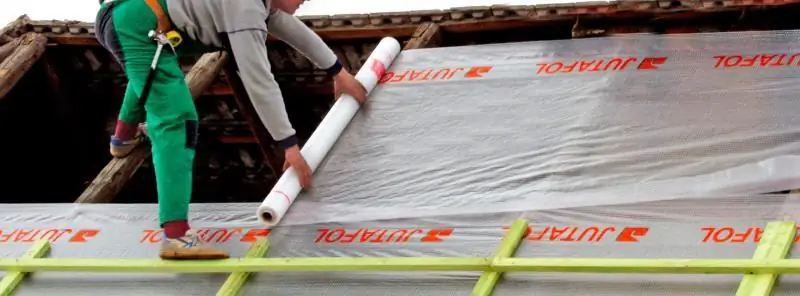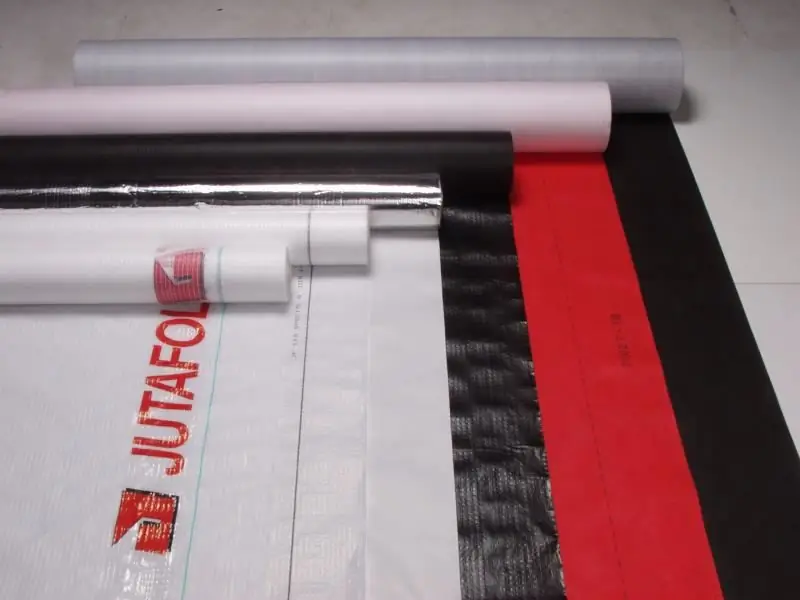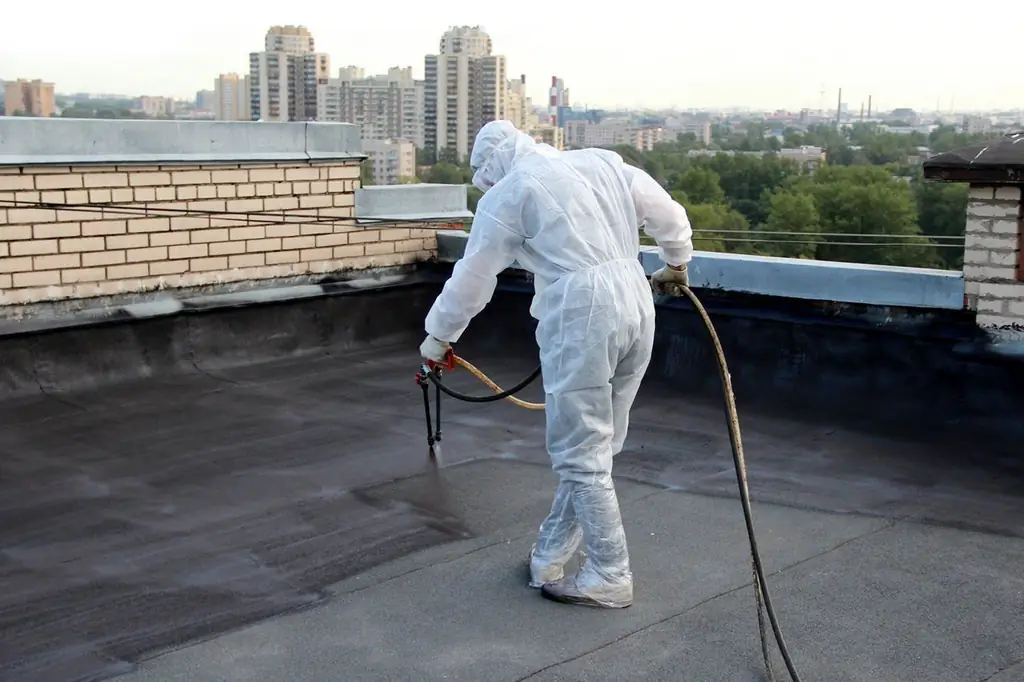
Table of contents:
- Author Bailey Albertson [email protected].
- Public 2023-12-17 12:53.
- Last modified 2025-06-01 07:32.
Roof insulation: selection and installation of materials

An insulated roof is a reliable protection of the building and prevention of heat loss, saving energy costs for insulation. Therefore, the arrangement of the roof is a priority during the construction of a residential building. At the same time, different materials can be used for thermal insulation, differing in characteristics, installation method and efficiency. Knowing these features will allow you to choose the ideal coating for the arrangement of a particular building roof.
Content
-
1 Types of roof insulation
1.1 Video: external roof insulation by means of "Polinor"
-
2 Thermal insulation materials and their characteristics
2.1 Video: roof insulation outside with mineral wool
-
3 How to prepare a roof for insulation
3.1 Choosing the method of roof insulation
-
4 Stages of installation of thermal insulation
4.1 Video: features of editing the material "Isover"
Types of roof insulation
There are several options for insulating the roof of a private house. The choice of the desired type is carried out depending on what function the attic space performs, and this can be a living room, a storage room or just a warmed attic. In any case, thermal insulation prevents the penetration of cold through the roof area and ensures comfort in the house.

The roofing cake of an insulated residential building consists of several layers
The organization of insulation is necessary in the case of arranging an attic room in the attic. If it is used for household purposes or is not functional, then you can do without insulation, but it is worth equipping the ceiling of the room or the floor of the attic.
Arrangement of the roof to prevent heat loss in the house can be internal or external. The first option is optimal for any type of roof and involves the installation of heat-insulating material from the inside of the room under the roof. The features of this species are expressed in the following:
- the structure of the roofing pie is created from the rafter system, installation of waterproofing and lathing, roof covering from the outside. Then a heat insulator, a vapor barrier membrane is installed from the inside, and then the finishing of the room follows;
- a gap of about 3-5 cm is left between the vapor barrier and the insulation, which is needed to drain moisture. This will help protect the materials of construction from decay;
- all popular heat insulators can be installed from inside the room, calculating the layer thickness and taking into account the technology of work.

With internal roof insulation, different methods of thermal insulation are possible
In the second case, the material is laid outside, which is often convenient for pitched roofs with a rafter system. Such external insulation requires careful calculation of the weight of the heat insulator, since there is a load on the load-bearing elements of the roof. The option is optimal for flat roofs, and during installation, rigid slabs are used, on top of which pebbles or concrete slabs are laid.
If an external arrangement of a pitched roof is required, then such work is carried out outside the building. Preliminarily remove the roofing, the supporting sheathing and the waterproofing film. After that, a base is mounted from boards with a thickness of 20 mm from the inside of the rafters, on which the insulation will be laid outside.
Video: external roof insulation by means of "Polinor"
Thermal insulation materials and their characteristics
For arranging the roof, you can use different materials, which are presented in a wide range and differ in characteristics, appearance, cost and installation method. It is these factors that are taken into account when choosing one or another component, and it is also important that the characteristics of the insulation must correspond to the climatic characteristics of the region, the type of roof and the method of arrangement. Another ideal material should have high sound insulation, long service life and resistance to moisture and fire, low weight.

You can equip the roof with different materials, but the insulation must have high characteristics.
Among the wide variety of materials, the following structures are in demand and are practical:
-
mineral wool is a well-known, affordable and practical version of a heat insulator, characterized by a service life of up to 25-30 years, minimal water absorption, low weight, good sound insulation and low thermal conductivity. The fibrous structure and high rigidity make cotton wool optimal for insulation. Manufacturers such as Rockwool, IZOVOL, Knauf, Paroc present many options for the material in rolls and plates, for example, with a reflective film that provides a high heat-retaining effect;

Paroc mineral wool slabs The Paroc brand produces practical and quality mineral wool options
-
structures based on polystyrene are in demand and diverse. These are expanded polystyrene, penoizol, extruded polystyrene foam. They are very light, presented in the form of plates, have good sound insulation and low thermal conductivity. Heaters of this type are distinguished by high flammability, destruction under the influence of ultraviolet radiation. The Penoplex, Extrol and Novoplex companies produce different versions of structures based on polystyrene at an affordable price;

Thermal insulator plates "Penoplex" Penoplex is practical and easy to install on different surfaces
-
cellulose fiber heat insulators are loose and light fibrous structures. They do not rot and are not affected by moisture, have antiseptic properties and provide good protection from outside noise. Flame retardants make the material resistant to fire. Manufacturers "Izotek", "Ekovata-Center" and others produce modern cellulose materials at an affordable price.

Cellulose insulation on the attic floor Cellulosic materials are laid on horizontal surfaces, providing protection against heat loss
Video: roof insulation outside with mineral wool
How to prepare a roof for insulation
Before direct installation of the insulation, the roof should be prepared. This is necessary both when arranging the attic room, and for simple thermal insulation of the attic floor.
Basic rules of preparation:
- all wooden elements of a pitched roof or concrete surface are cleaned of traces of mold and decay. You can remove such dirt from wood with sandpaper, and from concrete with a spatula;
- after cleaning, the surface is dried and an antiseptic agent designed for a specific material, for example, wood, is applied;
- after cleaning wooden, metal parts of the roof are covered with anti-corrosion or bituminous paint. Ordinary oil is also suitable, because these structural elements need protection from moisture and fungus;
- during preparation, they check the reliability of fastening all structural elements of the rafters, partitions and other parts of the pitched roof. In the case of a concrete roof, all cracks, chips and leaks are eliminated.

The surface to be insulated must be clean, dry, undamaged
For surface treatment, use a brush, spatula, roller. Dust is best removed with a vacuum cleaner, and concrete surfaces can be dried with a construction hairdryer. This will remove all the dirt and prevent rotting of the structure.
Choosing a method for installing roof insulation
Existing materials for arranging the roof are mounted using different methods and therefore you must first select it. The methods differ not only in technology, but also in the area on which work will be carried out.
To eliminate heat loss through the roof, the following arrangement options are suitable:
-
fixing the material between the rafters. This method involves placing insulation between the rafters. For this purpose, slabs or rolls are optimal, but it is worth considering that the rafters should be about 4-5 cm larger than the thickness of the heat insulator layer. This can be achieved by building up supports, that is, attaching additional boards. A vapor barrier film is mounted on top of the rafters, and then finishing the room begins;

Insulation of the roof with mineral wool between the rafters Warming between the rafters is convenient and does not require special skills
-
laying the material along the rafters is carried out when the required thickness of the insulation is greater than the width of the rafters. This method is also applicable if roofing has already been installed. To carry out work, a crate made of a metal profile or wooden boards is attached to the rafters from the inside of the attic, and then a heat insulator is fixed;

Application of sprayed polyurethane foam Sprayed polyurethane foam refers to rafter insulation
-
for a cold pitched roof, insulation of the attic floor is optimal. In this case, logs are installed, in the space between which heat insulator plates are laid, granular components, for example, expanded clay or cellulose material, are poured. On top of such a structure, an attic floor is laid.

Insulation of the attic floor with mineral wool Floor insulation is suitable if there is no need for thermal insulation of roof slopes
All methods differ in the cost of carrying out work by professional craftsmen. The most accessible is the insulation of the attic floor, since in this case you only need to equip a horizontal surface, and not work with slopes, corners and other difficult areas.
Stages of installation of thermal insulation
Arrangement of the roof from the inside is in demand. For this purpose, mineral wool in slabs or rolls is convenient, but you can use penoplex, polystyrene, since the technology of their installation is similar to laying mineral wool.
First you need to calculate the amount of material. To do this, calculate the area of the roof slopes from the inside, then determine the area that one roll of mineral wool or a package of slabs can cover. The average thickness of the insulating layer should be at least 15-20 cm, which is optimal for roofs made of corrugated board, metal tiles, soft roofs.

The minimum thickness of the thermal insulation layer is 15 cm
The roof is equipped with tools such as a tape measure, nails and a hammer, strong thread, a sharp knife, wooden blocks (if rafter extension is required). Slabs of mineral wool or a roll should be pre-cut into pieces of such a width that is equal to the distance between the rafters.
The main steps for arranging the roof:
-
The prepared pieces of material are tightly placed in the space between the rafters. For this, glue and other fasteners are not used. If the material has a reflective coating, then it should be located indoors. The material should not be pressed too hard, as its low thermal conductivity is provided by the fibrous and airy structure.

Roof insulation with mineral wool slabs For easier fastening, you can install profile elements and lay between them
-
At the end of the laying of the plates in one row, nails / screws are fixed on the extreme rafters or profiles, and a strong thread of synthetic fibers is pulled on them in a zigzag manner. Thus, the slabs will be securely fixed between the rafters.

Fastening mineral wool with wire You can use wire to secure the mineral wool
-
When laying each next row, make sure that the joints of the slabs of the previous rows are not located side by side. There should be no gaps between the wool slabs and the rafters. After arranging all areas, a vapor barrier film is attached to the rafters, but not pulling it tightly, and then the room is finished.

Decorating the attic with clapboard You can use clapboard to decorate the attic, but it must be treated with an antiseptic
Vapor barrier is an indispensable component of the roofing cake, because such a film protects the insulation from humid indoor air. Without this, thermal insulation will not be durable and effective even when using the best material.
Video: features of editing the material "Isover"
Various materials can be used to equip the roof and prevent heat loss, but their characteristics must always be taken into account. The technology of insulation also requires attention, because correct manipulations will ensure a good result.
Recommended:
Roof Membrane, Its Types And Brands With Description, Characteristics And Reviews, As Well As Installation Features

What is a roofing membrane. What types of membranes are used in the construction of various roofs. Membrane brands and features of their installation
Polycarbonate For The Roof And Its Types With A Description, Characteristics And Features Of Installation And Operation

Polycarbonate and its types. How to choose polycarbonate for your roof. Features of storage and installation, service life. Consumer reviews
Roof Vapor Barrier And Its Types With Description And Characteristics, Features Of Materials And Installation

Roof vapor barrier, its types, description and characteristics. Features of materials for roof vapor barrier. Installation methods for each of the materials
Roof Waterproofing And Its Types, As Well As Features Of Its Design And Installation, Depending On The Roofing Material

What materials can be used to arrange reliable waterproofing of the roof and how to install it
Roof Insulation And Its Types, As Well As The Materials Used With A Description And Characteristics

Roof insulation and its types. Why do you need heat, hydro and sound insulation of the roof. What materials are used to protect the roof and how to install them correctly
